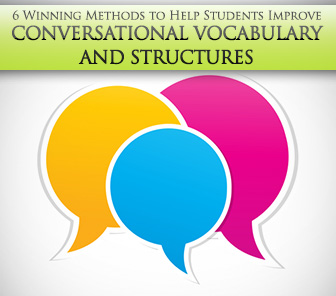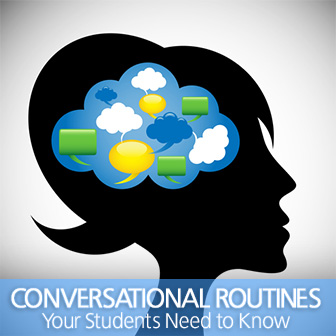6 Winning Methods to Help Students Improve Conversational Vocabulary and Structures Tomorrow


Except for a few big events—fires, illness, accidents—our everyday language seems to exist in set routines. There are some concerns with this, of course—boredom, superficiality, calling up the wrong phrase on occasion: e.g., “you, too” instead of “thank you.” However, there are even a larger number of advantages, especially for nonnative speakers: for example, lessened chance in making a mistake in grammar, vocabulary, or register because it is a set routine. In addition, going through the routine automatically frees up processing space in the brain so that the speaker can plan out the real “meat” of conversation after the routine—making a sale, asking for a date, etc. This is true even for native speakers of the language. Knowing these conversational routines is therefore a cultural expectation: e.g., a speaker who bids an ESL student to “Have a nice day” in farewell would probably feel slighted if the student did not respond in kind. Therefore it is important to teach students these routines.

These routines for greeting may be used as an opener to a more important conversation, or they may be used simply as greetings, to acknowledge the other person as he or she passes. Emphasis should be made on their function—that despite the wording, they are usually just greetings, not inquiries in the other speaker’s health and well-being.
A: Hi! How are you?
B: Not bad. And you?
A: How’s it going?
B: Can’t complain. And yourself?
A: And how are you today?
B: Very well, thank you.
Although one of the dialogues models the use of “you’re welcome,” it should be noted that Americans say this very little; it seems to have been replaced with “no problem.”
A: Wow! Thanks so much. I really appreciate it.
B: No problem.
A: I just want you to know how much this means to me.
B: It’s my pleasure.
A: Thanks! This is great.
B: You’re very welcome.
Complaining is done rather frequently in American culture, something that comes with being a consumer culture. There are therefore a number of ways to complain, from the cold and controlled to the flaming and hostile, depending on the situation. We of course would want our students to focus more on the controlled side, which actually is more likely to get results, along with being as specific as possible about the problem and what should be done about it.
A: I find this work on my car unacceptable. I’m still experiencing the same problem.
B: I’m sorry. I’ll have the technician look at it right away.
A: We’ve been waiting for our server for twenty minutes. Could you tell me how much longer it will be?
B: I’ll check on that right away, sir.
A: Excuse me. Would you mind turning down your music? It’s very loud, and I can hear it all the way down the street.
B: I’m sorry. I’ll get my son to lower it right away.
There are also numerous routines for apology, mostly to loved ones and friends, but also sometimes to relative strangers: the former tending to be more sincere and the latter more routine. Most apologies include an acknowledgement of the offense given and offer an explanation as to why. Except for the most serious offense, the person apologized to usually accepts it.
“No problem” is often used to accept an apology as well as in response to “thank you.”
A: I’m so sorry to have kept you waiting this long! Traffic was terrible.
B: No problem. I thought it was probably something like that.
A: I’m so sorry! Are you all right?
B: No problem. The train’s very crowded today.
A: Rob, I’m really sorry about this, but I’m going to be a little late on the report. I’ve had the flu the past couple of days.
B: Okay. Just get it in asap.
Finally, we have routines for farewell, which often don’t contain the word “good bye” these days but use other expressions. Included often are reasons why the speaker must leave.
A: I should let you go. I have to get dinner started.
B: Well, it’s been nice talking to you. See you soon.
A: Well, I’ve got to go now. I have to meet my wife at the dinner.
B: Okay. Have a great weekend!
A: Well, it’s been great catching up, but I have just a pile of work…
B: Yeah, me too. Let’s plan to get together for lunch sometime.

Because these routines are more or less set (e.g., the appropriate response to “How are you?” is some variation of “fine”), have students match the routine opening sentence with the correct response. This will prepare them for coming up with the correct responses in actual speech situations.
Blank out part of a written dialogue: e.g., A: Hi! ____ are you? B: Not ___. And you? This will further help students process the routines and learn them to the level of automaticity.
Give out “butchered” dialogues, with errors in grammar or usage: e.g. “How’s are you?” “Bad! And you?” Correct and discuss the errors.
Have students get into pairs or groups. Have them choose the basic situation and the characters or assign them. The students then work together to create one or two conversational routines.
After writing their dialogues, students can practice and perform them in front of the class, or trade class routines with another group and perform theirs.
Go to Starbucks or another cafe. Stores, restaurants, and other public places where people engage in conversation, like a park, are also possibilities. Have students note which conversational routines people engage in. Discuss them back in class.
The routines can be for a wide range of places; the similarity between them is the function: to greet, to say farewell, and so on. Knowing the function of the different routines will help students develop speaking skills appropriate to the situation with a level of fluency.


